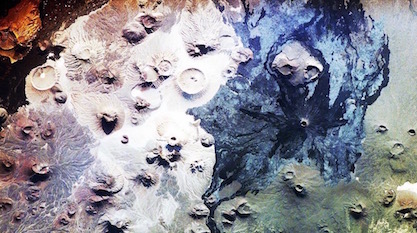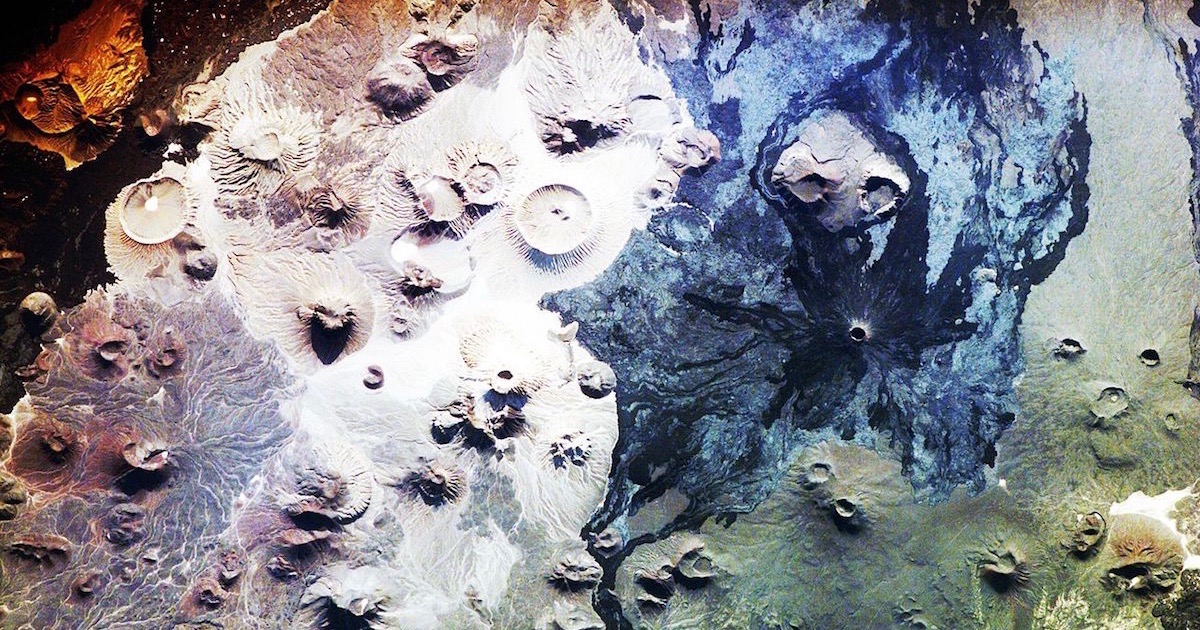 Intelligent Design
Intelligent Design
Mysterious Structures in Arabian Desert: All We Know Is that They Were Designed


The news media were swept up in a mystery recently, when an Australian archaeologist told how he used Google Earth to discover mysterious rock structures in the Arabian desert. He and his team want to investigate and figure them out. “As of now, researchers have more questions than answers regarding what these structures were used for, who built them, how old are they, and their meaning,” says an article at Forbes. (Emphasis added.)
You can see a gallery of the so-called “gates” in Live Science. You can even find them on Google Earth yourself, if you want to do a little armchair archaeology, by searching for “Harrat Khaybar” and scouting around, trying to match landforms to the photos. We’ve reported finds like this before (here and here). The article at The Express UK says:
David Kennedy, a professor at the University of Western Australia, who helped to discover the gates through satellite imagery, said they “are stone-built, the walls roughly made and low.”
He adds that they “appear to be the oldest man-made structures in the landscape,” and that “no obvious explanation of their purpose can be discerned”.
Only one piece of evidence is helping to nail down the age of the structures. A few of the structures are partly covered by lava flows. That means that they had to be built before the most recent eruptions in this lava field, which could be as recent as 1,300 years ago, or up to 7,000 years ago. Kennedy wants to radiocarbon date the remains if he can launch an expedition. Knowing the date of the oldest structures can help identify what humans lived in that area at the time. Forbes says,
The team will soon publish their research in the journal Arabian Archaeology and Epigraphy. However, this is just the tip of the iceberg, as the saying goes. The next steps will be to lead an archaeological survey of the area, allowing the research team to collect samples and inspect the gates more closely. They will be able to carbon age date the lava fields and potentially the stone walls to determine the timing of construction. In addition, they may find more examples of what these strange people were like in this remote region of Saudi Arabia.
We can relate to Kennedy’s immediate sense that these structures were man-made, because we are human and know what humans do. And readers of Evolution News, as intelligent design advocates, could run our handy-dandy Design Filters and decide that these structures pass the test: they are not products of chance or natural law, and they contain specified information. But we would want to apply sufficient rigor, because a look at the surroundings with Google Earth shows some parallel lines that could be “natural.” Some of the perfect circles we see are clearly volcanic vents, also not candidates for design. Then there is the issue of distinguishing the ancient “mysterious” structures from a few modern roads and buildings out there.
Assuming our results concur with Kennedy’s, we can also relate to his enthusiasm to find an “explanation for their purpose”. But we know that intelligent design theory does not need to know the purpose of an artifact; it is sufficient to deduce that some purpose or intent was involved. Intelligent design stops when we try to figure out the who and the why. For instance, in cases where we have good reason to think a cosmic designer made something, we go too far in ID to specify it was God, or to presume to know what God’s purpose was. Those questions are better addressed by theologians after the design inference is made.
But we must also clear up another issue as well: what do we mean by purpose or intent? If not careful, we attribute intent to honeybees who build elaborate honeycombs for the purpose of laying their eggs. The living world is rich with complex patterns exhibiting function that result from animal behaviors: bird nests, termite mounds and ant hills, and this striking example produced by a puffer fish as part of its mating dance (see this BBC video). Are we to locate the intention in the tiny brains of bees and ants?
We might argue that the Arabian ‘gates’ show design because they go beyond mere survival needs. But even then, we can’t easily dismiss animal behaviors with that argument, because some animals seem to make artworks of gratuitous beauty. The elegant glass houses of diatoms, for instance, don’t seem to require such elegant geometrical perfection to be functional. Nor do the Golden Ratios of plants that we talked about recently seem necessary for survival.
Evolutionists, in their reductive mindset, are likely to lump human designs into the same basket as termite mounds. Building things is just something the human animal does. Rock structures in the desert are mere consequences of large human brains and evolved behaviors, they might say. In this view, intent and purpose get swallowed up by the all-encompassing blob of natural selection. How do we escape that line of argument? How do we defend true intention for intelligent design?
Nancy Pearcey, a Discovery Institute Fellow and a contributor to these pages, has shown one sure-fire strategy. In her latest book Finding Truth, she argues that if Darwinians want to reduce human purposes to natural selection, then we need to show them that their explanation points both ways. What’s good for the goose is good for the gander: if natural selection produced humans who built the Arabian structures, then it also produced academic professors who write journal papers attributing everything to natural selection. Obviously, such an argument implodes in on itself. The only way to argue for evolution is to plagiarize theistic positions, which take truth and purpose seriously. Without believing in truth and intent, a Darwinian commits intellectual suicide.
Having established that truth and intention cannot be artifacts of chance and natural law, we can employ them to re-examine cases of animal designs. Instead of attributing intent to honeybees, plants, or birds, we can locate the intent in something higher. Our own programmed systems (robots, computer networks, and so on) were intended to function using parts that we arranged for that purpose; the parts would never do those things without our guidance. This distinguishes the ‘human animal’ from the rest of nature without diminishing our physical attributes and commonalities with primates. Bodies enable our human minds to choose to design things.
Since in our uniform experience every system exhibiting functional coherence (to use Doug Axe’s term in Undeniable) — wherein we witnessed the system coming into being — was the product of human intelligent design, we can use the principle of uniformity to infer that a mind was behind the functionally-coherent systems we did not witness coming into being (provided they pass the Design Filter). The designing mind, additionally, must have the ability to apprehend truth and intention as genuine qualities of personhood. (Without that, all explanation comes crashing down.) Any scientist proposing to offer a scientific explanation, therefore, must necessarily presuppose that truth and intention are fundamental properties of intelligent agents.
Looking back at those stone structures decaying in the desert over thousands of years, we can feel some kinship to the makers, even if we don’t know them. Like us, those human beings had minds. Like us, they had purposes. For whatever reason, their intelligent, designing minds set them to work building large rows of stones, some of them almost 1,700 feet long, for reasons we can only guess at. What’s not in doubt is that they had a plan.
Photo: Harrat Khaybar, by Expedition 16 Crew Member on the International Space Station, NASA (NASA Johnson Space Center (direct link)) [Public domain], via Wikimedia Commons.
